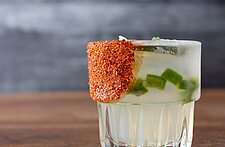 It’s hard to deny the appeal of pizza, which not only offers a filling bread base but allows for incredible customization. There's something for everyone, with countless combinations of cheeses, meats, veggies, and other inventive toppings, not to mention opportunities to appeal to alternative diets (dairy-free, gluten-free, vegan, etc.).
It’s hard to deny the appeal of pizza, which not only offers a filling bread base but allows for incredible customization. There's something for everyone, with countless combinations of cheeses, meats, veggies, and other inventive toppings, not to mention opportunities to appeal to alternative diets (dairy-free, gluten-free, vegan, etc.).
Perhaps this is why pizza is such a popular food type, not just in the U.S. but around the globe. What does pizza look like in other countries? What’s trending on the international pizza scene, and how can U.S. businesses break into these markets?
Peppers Galore
Peppers on pizza are nothing new. Bell peppers are a staple topping, and many a pizza box includes pepperoncini for diners who want to add a touch of heat. Jalapeños aren’t hard to find at most pizza places, either.
That said, new peppers are entering the fray internationally, adding sweetness and spice to the dining experience.
International faves include everything from mild pasilla, shishito, and cherry peppers to sweet banana and piquante peppers to spicier Calabrian chili peppers. Infused chili oils are also a popular addition to pizza in other parts of the world.
Vegan Variations
Vegan foods are gaining popularity both in the U.S. and around the world, and pizza is a prime target for transformation.
Cashew milk cheeses like mozzarella have emerged as a leading cheese alternative, not only because of the satisfying flavor but because they tend to offer the closest texture to melty cheese. Liquid cheeses are especially ideal for matching texture.
As for meats, there’s no shortage of vegan pepperoni options, along with plant-based bacon, sausage, chorizo, and more.
Related: The Current State of America’s Favorite Food
 Meat and Greet
Meat and Greet
Meats are a common addition to pizza, with pepperoni, sausage, and bacon among the most popular options. Pepperoni, however, is enjoying a recent glow-up, with options like old-world pepperoni (featuring natural casings), charred pepperoni (which cups when cooked), and spicier blends gaining popularity.
Another trend in global pizza toppings is the use of prepared meats like birria, carne asada, shawarma, brisket, and pulled pork. Choosing slow-cooked and flavorful meat dishes that are already known and loved provides consumers with appealing new ways to assemble a pie.
Not all protein is meat, and one interesting option grabbing the attention of diners lately is caviar. This luxury food item is enjoying a recent revival. Truffles have become a more accessible and affordable luxury item in both restaurant and at-home food markets over the last few years, and caviar is currently poised to follow suit.
Want to learn more about chicken products, flavors and trends? Contact us today!
Seasonal and Locally Sourced Ingredients
Sustainability isn’t just important in the U.S. market. Consumers around the world are embracing products and practices that do less harm to the environment. This is showing up in seasonal and locally sourced ingredients that draw on the culture and cuisine of different countries and regions.
Herring is a popular pizza topping in Russia, while Japanese diners might prefer eel or squid. Green peas and corn are found on pizza in Brazil, while diners in Costa Rica are keen on pizza pies topped with shredded coconut.
Utilizing local ingredients not only allows different cultures to make pizza their own, but it helps to cut costs and boost sustainability.
 Breaking Into International Markets
Breaking Into International Markets
Pepperoni may be king with American pizza lovers, but other toppings, flavor profiles, and trends tend to reflect the tastes of international diners in different regions.
If you’re interested in breaking into these markets, understanding trends helps you innovate while still appealing to local consumers. This could mean hopping on the latest trends or trying fusion mashups that bring American flavors to a global market in palatable and attractive ways.
Never miss an update! Stay in touch! Sign up for our newsletter here






